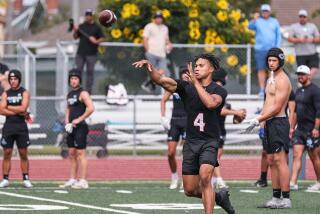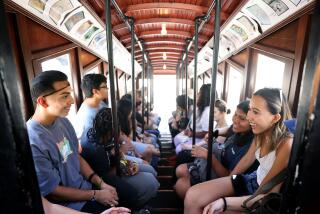HIGH LIFE : VENI, VIDI, VICI : Students Put Some Life Into ‘Dead’ Languages
An observer scanning the campus of San Marino High School last weekend might have thought he had taken a wrong turn in the wrong century and ended up in ancient Rome.
A closer look at the hundreds of sandals, olive branches and togas, which ranged from basic white to sultry red satin sheets, and he might instead believe that he was on the set of “Animal House II.”
But in reality, the school near Pasadena was playing host to 1,200 delegates at the Junior Classical League’s 33rd annual California convention.
Despite what you may have heard, Latin, that centuries-old language, is definitely not dead.
Latin “is not the same place and not the same thing,” said Nicki Cathers, recording secretary for the California Junior Classical League and a fifth-year Latin student at Troy, who claims that she “didn’t want to fall into the rut of the usual Spanish and French classes.”
“The more serious students are beginning to see the academic benefits that Latin provides for an upper edge on things like the SAT (Scholastic Aptitude Test) and basic English vocabulary,” she said.
Les Johnson, the league’s chairman and Latin teacher at University for 12 years, said the increased interest in the language “has to do with teachers and key students.”
“Teachers work hard to create a positive atmosphere for Latin, and students see the value of what Latin can do for them,” said Johnson, who brought 119 students to the convention.
Johnson said 227 students participate in his school’s Latin club and 260 take Latin classes at University, the highest enrollment of any such program in the state.
The Classical League boasts 2,200 student members from 50 high schools, well up from the 900 students and 21 schools four years ago.
“I had always heard all the fun things the Latin club did, so this year I decided to join in on some of the toga parties and attend (the) state convention,” Troy senior Jenny Gillette said. “I’m definitely glad I did.”
The three-day convention featured schools vying for points in Roman-style contests in areas of artistic, athletic and academic excellence.
The art competition included such categories as costume design, painting, original music composition, sculpting and video production.
And while the athletic competition featured the stuff of which Olympics are made--track and field, swimming, volleyball and basketball--the convention’s main event was the chariot races held during the Ludi Games or “Crazy Olympics.”
Deviating from the chariots the Romans raced in the Colosseum, these modern-day vehicles were designed and built by Latin club members using everything from sturdy wooden carts to plastic tubing and 10-speed bicycle wheels. They were pulled by teams of up to four male runners with a female driver, and vice versa.
“It gets to be a really exciting race sometimes,” said Michelle Spiegel, co-consul of Troy’s Latin club. “Two years ago at Miramonte High School, a girl on an opposing team fell right in front of our path and we just kept on running right over her leg. I think we got second.”
This year, Glendale Hoover won the girls’ race, with University finishing second and Newport Harbor third. In the boys’ competition, Santa Monica was the winner, followed by Corona del Mar and University.
Sunny Hills High, a relative newcomer to the convention, dominated the swimming contests. Juniors Danny DeLaCruz, Danny Leyson and Adam Smith won three medals each, and junior Joyce Lightfoot and freshman Carey Smith were awarded four medals between them.
Since the Romans stressed the importance of both brawn and brains, academics are also an integral part of the convention’s activities, with such contests as Roman daily life and history, Roman numerology (mathematics up to trigonometry using Roman numerals), mythology and Latin vocabulary.
“For some students, these tests are do or die,” said Keith Kitagawa, a University senior and league vice president. “Mostly it is low-keyed with no pressure, though.”
Other academic competitions were essay, poetry and modern myth writing, and original and dramatic oratories.
The most challenging of the academic events is called the Certamen, which means “the struggle.”
The Certamen is played by three four-member teams from each school that match wits against other schools in such areas as Latin grammar, mythology, history and everything in between.
Cathers described the Certamen as “the academic decathlon of Latin.”
“It’s actually a pretty stressful situation,” Cathers said. “I remember I was so nervous my first year that I couldn’t even figure out how to work the buzzer system.”
University’s Certamen teams had been practicing since December. In Orange County’s first regional Certamen, organized by University sophomore Nelson Lu and held at his school in February, University made a clean sweep, earning first places on all three levels.
But at San Marino, University finished second in the first-year Latin division to Santa Monica, second in the second-year division to Corona del Mar and second in the advanced division to Palo Alto High.
University did, however, win the sweepstakes award for the fifth consecutive year, though because the school hosted last year’s state convention that title went to runner-up Hoover. This year, Hoover again finished second and Corona del Mar third.
Other weekend festivities included the crowning of a Mr. CJCL (Miramonte’s Sanjeev Ravipudi) and Miss CJCL (Hoover’s Kara Finstrum) and a slave auction, which raised $159 for the league’s scholarship fund. Each year, league provides scholarships of $1,000 to two students interested in continuing their study of either Latin or Greek and $3,000 in scholarships to students attending the national convention.
The national convention will be at the University of Colorado in Boulder, July 29 to Aug. 5.
Johnson says his unbridled enthusiasm for the conventions stems from the fact that they give students “the opportunity to use Latin in a very real way and to show them that Latin is very much alive in their everyday life.”
More to Read
Sign up for Essential California
The most important California stories and recommendations in your inbox every morning.
You may occasionally receive promotional content from the Los Angeles Times.










